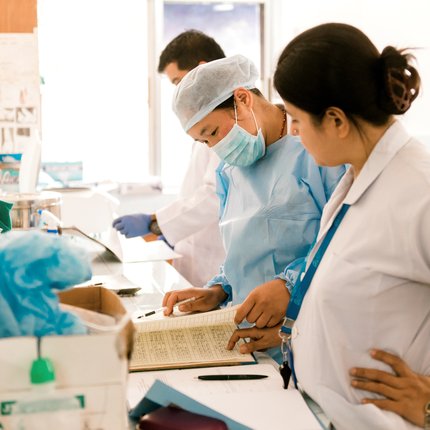Research in Nepal

A hub for some of leprosy research's greatest moments
Established in the 1970s to study the human immune responses to M. leprae, the Mycobacterium Research Laboratory (MRL) at Anandaban Hospital in Nepal is an essential part of our global research hub, which is comprised of three main centres (MRL, the Field Research Programme in NW Bangladesh and the Stanley Browne Laboratory in India). Our team of researchers at Anandaban are leading on some of the world's most ground-breaking leprosy research.
In addition to our molecular research, we conduct clinical trials, operational research and social research.
Whilst multi-drug therapy has been very successful in reducing the global prevalence of leprosy, new cases still occur. This indicates that leprosy transmission is still taking place despite effective treatment.
Discerning the difference between live and dead bacteria is the most fundamental procedure in microbiology and has been one of the primary obstacles impeding research in leprosy. Our inability to easily culture M. leprae and determine its viability makes monitoring the progress of treatment in patients challenging and limits our ability to design improved drug therapy regimens and chemoprophylaxis programmes.
It is difficult to follow the transmission of leprosy bacilli between individuals, and we do not really understand the contribution to leprosy pathology of the accumulation of large numbers of presumably dead bacilli in the nerves and skin of patients under therapy. Modern molecular methods can allow us to finally bridge this gap with new technology that can better serve both persons affected by leprosy and leprosy workers in a variety of settings.
Together with laboratories at the National Hansen’s Disease Program-Laboratory Research Branch, Baton Rouge, LA, USA and Leonard Wood Memorial Center for Leprosy Research, Cebu, Philippines, we have set up the International collaboration for translation of Mycobacterium leprae molecular viability assay (MVA) to the clinical setting
The MVA is an accurate, sensitive, field-friendly test which can be applied in both clinical and research settings. Clinical uses of MVA include:
- Monitoring treatment
- Confirming suspected relapse.
- Evaluating different PEP treatments
Research partners: US Department of Health and Human Services National Hansen's Disease Programs.
Funding from Leprosy Research Initiative and The Turing Foundation
Despite successful use of MDT, leprosy incidence has remained constant at around 200,000 cases annually, indicating continuing transmission. Sub-clinical infections in household contacts is one potential ongoing source of transmission, and numerous post-exposure prophylaxis (PEP) regimens have been proposed to control this source. TLM is excited to have this new tool in our kit to defeat leprosy.
However, as much as we welcome single-dose PEP, studies conducted by TLM and presented at the International Leprosy Congress 2019 in Manila, Philippines, demonstrate that while single dose PEP regimens may be effective in household contacts with decreased susceptibility, they may not be as effective in highly susceptible contacts. In contrast, all of the multi-dose combination therapies were effective. Thus, in highly susceptible individuals with subclinical disease, multiple doses of PEP are more effective at controlling multiplication and potentially decreasing transmission.
Our research continues.
Antimicrobial resistance (AMR) is a priority for surveillance in bacterial infections. It is a critical activity in the World Health Organization's Global Leprosy Strategy 2021-2030
Thankfully, the resistance to first line drugs (rifampicin and clofazimine) appears low, but as post-exposure prophylaxis is scaled up, it is essential to expand AMR monitoring.
TLM Nepal and TLM Trust India are both members of the WHO surveillance network of antimicrobial resistance in leprosy which published some of its findings in 2018: Antimicrobial resistance in leprosy: results of the first prospective open survey conducted by a WHO surveillance network for the period 2009-15
Leprosy is caused by a bacterium and is curable with a combination of antibiotics known as multi-drug therapy, which patients take for six or 12 months. However, a significant proportion of leprosy patients experience severe inflammation in their skin, nerves and other organs known as erythema nodosum leprosum (ENL). ENL is a severe complication of leprosy which can occur before, during, or after completion of antibacterial treatment. ENL causes severe morbidity affecting not only the skin, but also bones, joints, eyes, nerves, testes and kidneys. ENL may be fatal and it has been shown that the adverse effects of corticosteroid treatment also contribute to mortality.
ENLIST group (Erythema Nodosum Leprosum International STudy Group)
TLM Nepal and TLM Trust India are both members of the ENLIST group.
The ENLIST group is increasing our understanding of the risk factors for ENL, how to measure its severity and improving how we treat ENL and support those who suffer with it. Read more about ENLIST here.
Alternative treatments for ENL
An effective treatment for ENL is thalidomide but this is not available in many leprosy endemic countries or is severely constrained by availability, cost and justified concerns about teratogenicity. Thalidomide, despite its effectiveness, is rarely used as a first line agent.
The last therapeutic agent for ENL treatment was developed about 50 years ago; and there is an imperative need for new therapies with fewer side effects to be identified. While prednisolone and thalidomide are recognised treatments for ENL, the majority of patients will need long term treatment, both drugs have significant side effects, and thalidomide is restricted or prohibited in some countries.
CC-11050 is a non-steroid, anti-inflammatory drug with few side effects acting as a Phosphodiesterase 4 inhibitor (PDE4i) that has been previously trialed and shown to be safe in humans as well as tested against other inflammatory skin conditions. Early research demonstrated it has potential for treating ENL.
Most (>94%) of global annual new leprosy cases are from populations co-endemic for soil-transmitted helminth infections (STH). STH is another neglected tropical disease (NTD), and can affect the body's immune response.
In 2017, TLM Nepal published Opening a Can of Worms: Leprosy Reactions and Complicit Soil-Transmitted Helminths
Our team in Nepal constinues to study the relationship between leprosy STH - aim to investigate meaningful relevance of anti-helminthic treatment to clinical leprosy outcomes and to see if there might be an influence on leprosy immuno-diagnostic tools.
Diagnostic tests for reaction: MRL has discovered evidence that urine contains biomarkers that may help the development of and early diagnostic test for leprosy reactions. We continue to work with our global partners such as Prof Annemieke Geluk at LUMC, Netherlands.
Routine leprosy ulcer care can be insufficient to address large or deep trophic ulcers – which can require long stays in hospital and can significantly affect patient’s income, employment, household and quality of life.
Autologous leukocyte-platelet rich fibrin (L-PRF) containing growth factors has been demonstrated in clinical studies across dental, diabetic, leprosy and venous ulcer care to regenerate tissue and reduce overall healing time.
Dr Inda Napit, experienced surgeon at Anandaban Hospital conducted a pilot study to evaluate efficacy of L-PRF therapy in trophic leprosy ulcers. The pilot demonstrated that L-PRF therapy is safe, effective and simple to perform in hospital or outpatient settings by nursing or paramedic staff. If Dr Indra and his team can show that L-PRF, is a viable, cost-effective way to manage leprosy ulcers, it could revolutionise how we manage ulcers in the future and will help people affected by leprosy not just physically, but emotionally and economically too - getting them back to work sooner.
Following the pilot study, we have succeeded in obtaining funding from NIHR for a bigger study looking into transforming the treatment of ulcers. Read more here.
Evaluation of a self-help intervention to promote the health and wellbeing of marginalised people including those living with leprosy in Nepal: a prospective, observational, cluster-based, cohort study with controls
Leprosy is an infectious disease known for being an extremely stigmatised condition. Knowledge, fears and beliefs about leprosy are crucial drivers of stigma. Religion and faith shape beliefs, attitudes and behaviours and have been found to both reduce and increase leprosy-related stigma. However, how and to what extent religion influences knowledge, fears, beliefs and attitudes towards (persons affected by) leprosy is not well understood. In addition, the role of religiosity (religiosity broadly encompasses religious orientations and involvement) as a source of strength and resilience also warrants further investigation.
This study aims to investigate the influence of religion and religiosity on leprosy-related knowledge, perception and resilience among Hindu and Muslim populations in Kapilbastu district, Nepal. The findings of this study will increase our understanding of the different beliefs and perceptions regarding leprosy in Hinduism and Islam and the influence of these on leprosy-related knowledge, attitudes in the community and resilience of persons affected. In addition, this study will increase our understanding of how religiosity influences perception and resilience.
Research partners = Enablement, Netherlands

